 Written by Mike Price, OT
Written by Mike Price, OT
There are many challenges faced by people who live with limited mobility, and using the bathroom can be one of them. If you have difficulty lowering into a sitting position or rising to a standing position, a bathroom trip can be anything from a time-consuming inconvenience to a dangerous fall risk. The ability to sit on a higher toilet decreases the distance from a standing to a sitting position, making toileting a safer and more comfortable experience.
Replacing your toilet with a taller model is a major project with a significant price tag. A great alternative is to add an elevated toilet seat to your existing toilet. This economical option is a discrete and comfortable addition to the toilet, and it can be very easy to install. Your whole bathroom experience can be transformed by choosing the right elevated toilet seat.
Anyone who struggles with lowering to sit or rising to stand on their own,is recovering from back, hip or knee surgery, is prone to falls because of poor balance, has low strength, or requires assistance to use the bathroom can benefit from an elevated toilet seat. This is especially true for anyone who wants to maintain as much personal independence as possible. An aversion to asking for help often leaves people struggling to use the bathroom on their own, even when it isn’t safe to do so. Lower body weakness and balance issues are among the top causes of falls at home. An elevated toilet seat can mitigate the risk of a bathroom fall by decreasing the distance between the standing user and the toilet seat.
A toilet seat riser, also known as a toilet seat extender, is a platform for the toilet seat. The riser attaches to the toilet bowl and is positioned under the seat, which is raised up several inches by the riser.
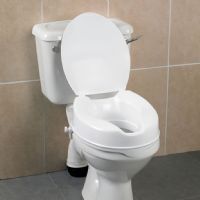 | Savanah Raised Toilet Seat with Lid View Product |
The three common types of raised toilet seats, which are used in place of standard seats, are basic raised seats, raised toilet seats with a lock that attaches to the toilet bowl, and raised toilet seats with arms that provide users with something to lean on for leverage while lowering to sit or rising to stand. Raised toilet seats come in heights of 2, 4, 5, and 6 inches and are sometimes called elevated toilet seats, high-rise toilet seats, and toilet booster seats.
 | GentleBoost Uplift 3-in-1 Commode Shower Chair by Platinum Health View Product |
A commode chair is a free-standing toilet chair that can be set up anywhere - usually bedside - for people who find walking to the bathroom difficult or even dangerous. The lifting seat greatly reduces the risk of a fall while using the commode chair, acting as a patient lift and eliminating the need for the patient to manage sitting down and standing up.
 | Elongated Raised Toilet Seat by AquaSense View Product |
An elongated raised toilet seat has a contoured oval design, extending out several inches in front from the bowl to provide extra comfort and support. This extended design is suitable for users weighing up to 300 pounds.
For people with balance and lower body strength issues, the addition of support arms gives users hand grips to steady themselves and use for leverage while raising and lowering onto the toilet seat.
A hinged elevated toilet seat has two parts hinged together. This design allows the ring to raise like a standard toilet seat for others to use the toilet with the seat up.
 | Clean Shield Elevated Toilet Seat by BEMIS (Support Arms optional) View Product |
Bariatric heavy-duty elevated toilet seats are made for heavier people, and there are models that can accommodate users weighing up to 1200 pounds.
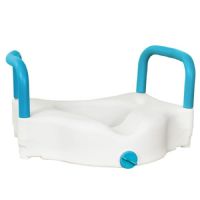 | AquaSense 3-in-1 Raised Toilet Seat View Product |
A contoured raised toilet seat accommodates the body’s natural curves, providing a comfortable seat. It also provides improved access, which creates a healthier environment by contributing to hygienic toileting.
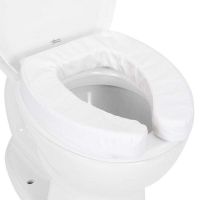 | Padded Toilet Seat Riser by Vive Health View Product |
A padded, elevated toilet seat, sometimes referred to as a commode cushion seat, is more comfortable than a regular raised toilet seat, which can be stiff and cold to sit on.
 | Clean Shield Elevated Toilet Seat by BEMIS (Support Arms optional) View Product |
Using a toilet seat riser and lid combo utilizes your existing toilet seat to provide a stable, non-slipping safe elevated toilet seat. There are some elevated toilet seats that have a discreet, reverse funnel which keeps everything directed towards the toilet bowl.
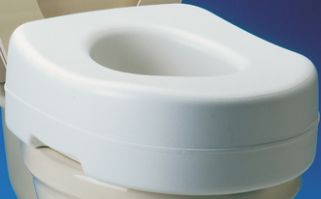 | Raised Anti-Slip Contoured Toilet Seat View Product |
One issue with raised toilet seats is that they can slip a bit, which can be disconcerting when a user already facing balance challenges sits onto a seat that slides around a little. Slip-resistant rubber pads on the raised seat can keep it from moving when in use. If the seat is also wider and contoured, it cradles the user better, providing a more comfortable stable seat while preventing movement.
 | Savanah Raised Toilet Seats by Performance Health View Product |
Elevated toilet seats come in heights of 2, 4, 5, and 6 inches. If the toilet seat is too low, the user’s legs will be bent and the knees won’t be level with the hips, which puts the users into an uncomfortable position and can make it difficult to stand.
 | Drive Medical Raised Toilet Seat With Lock View Product |
For people who travel or are in a temporary living situation, a portable elevated toilet seat is easy to install and remove without any tools or hardware. Rubber pads keep the seat from slipping and make it easy to take it off the toilet and take along when it’s time to move on.
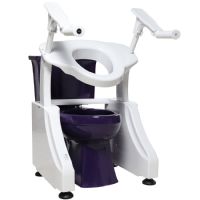 | Deluxe Toilet Lift by Dignity Lifts View Product |
Standard toilet lifts require physical exertion by the caregiver and the user during toilet transfers. A battery-powered toilet lift allows for independent toileting for the user without having to put forth any physical effort. For people who don’t have the strength to safely bear weight while transitioning between sitting and standing, a powered toilet lift provides the necessary support for a safe transfer.
 | Padded Drop-Arm Commode by Medline View Product |
Movable toilets that don’t require a water supply, bedside commodes are great for people who struggle getting to the bathroom for toileting. A bedside commode, which has a toilet seat over a removable container, provides a portable toileting option when a user can’t easily get from bed to the bathroom when needed.
 | Free2Go Rollator with Built in Commode Seat View Product |
A rollator with a hideaway toilet seat allows a user with balance, coordination, or gait issues to take a raised toilet seat discreetly with them no matter where they are. The user can walk the rollator up to a standard toilet, flip up the rollator seat to reveal the rollator’s raised toilet seat, lean on the rollator frame for stability while transitioning between standing and sitting, and when finished simply flip the rollator seat over the toilet seat and exit the restroom.
 | Etac Supporter Toilet Arms View Product |
Toilet arms are mounted to the side of a toilet to provide support for sitting and standing. They can be folded up and out of the way when needed. For users who need something to lean on to safely make the transition on and off the toilet, the arms allow them to use their upper body strength to lower and raise themselves.
 | Guardian Toilet Safety Frame by Medline View Product |
For anyone recovering from knee or hip surgery or with balance or lower body strength limitations, toilet safety frames provide handrails on either side of the toilet to assist in sitting and rising. They don’t affect the toilet seat and do not change the user experience for anyone else using the restroom who doesn’t need this safety feature.
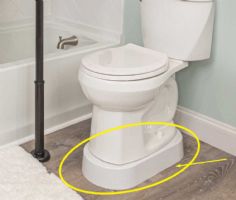 | Toilet Base Riser - Toilevator from Hartmobility View Product |
Want the benefits of a higher toilet seat without the obtrusiveness of an elevated seat? A toilet base riser adds height to the toilet at the floor, without any modification to the toilet seat. This ADA-compliant device is great for facilities serving a diverse patient population with various needs.
 | Swash 1400 Luxury Bidet Toilet Seat by Brondell View Product |
Although not a seat lift, a bidet will contribute to good hygiene by providing a thorough cleaning after toileting. Nothing gets missed, and no wiping is required by the user or a caregiver.
Because elevated toilet seats are personal hygiene items, in most cases they are not returnable, so do your research, measure correctly, and explore all your options to ensure you make the best purchase decision.
If your bathroom aesthetic is important to you, you can get an elevated toilet seat that is less obtrusive and blends in like other fixtures. It might match the color of the toilet or fold out of the way or be the same size as the bowl. If that is less important to you than getting a model that is a certain height or has a special feature that doesn’t necessarily match your bathroom, you are not limited in color or design options.
Since measuring for the appropriately sized elevated toilet seat is the first step in making an informed purchasing decision, keep in mind the height of the toilet, the shape of the toilet bowl (round or elongated), and the height of the user when shopping for an elevated toilet seat.
There are elevated seats, those that rely on slip-resistant pads for example, that don’t change the toilet at all and allow for tool-free installation. Others are secured with fasteners, might require removal of the current toilet seat, and are secured by removable or permanent clamps, bolts, or brackets. The models that require the most effort to install are usually the most secure, so there is a tradeoff between convenience and level of stability to be considered.
The standard weight capacity of an elevated toilet seat is in the 250-300 pounds range. For bariatric models, the weight capacity can be as high as 1200 pounds.
Since elevated toilet seats can range in height from 2 to 6 inches, it’s important to measure correctly. To determine the correct seat height, measure from the floor to the back of the user’s knee, then measure from the height of the toilet seat from the floor. Subtract the measurement of the toilet from the peron’s knee height, and the difference between the two is the correct height for an elevated toilet seat.
Because elevated toilet seats can extend beyond the outside of the toilet, especially with seats with arms or frames, it’s important to have enough space around the toilet to accommodate the additional space an elevated toilet seat requires. By measuring the area around the toilet, you can determine what elevated toilet seat models will best fit in your bathroom.
A bolted raised toilet seat is the best option if using a seat with a lid is a necessity. Non-bolting raised toilet seats keep the lid from moving, and the seats must be removed to close the lid. If a necessary, then a bolted raised toilet seat may be ideal. A non-bolting raised toilet seat will prevent the lid from going up or down. The seat will have to be removed to put the lid up or down. Raised toilet seats installed with bolts sit under the lid, which can be raised and lowered.
A: Yes, they generally come in 2, 4, 5, and 6-inch heights
A: For people with diminished mobility, including balance issues and muscle weakness, raised toilet seats reduce the distance a person has to move when sitting down or standing up from the toilet.
A: A raised toilet seat ensures your knees are not higher than your hips when sitting on the toilet seat.
A: Yes. They can significantly lower the risk of a bathroom fall for the elderly by decreasing the distance needed to lower onto or rise from the toilet.
A: Raised toilet seats can be cleaned with a non-abrasive detergent or household cleaner with warm water or a diluted disinfectant.
A: The best raised toilet seat is one that fits the user well and provides a safe platform for toileting.
A: A raised toilet seat is placed on top of the current toilet bowl. It's used to raise the height of the toilet. It can help make sitting down and getting up from the toilet easier and safer.
Because the bathroom can be one of the most dangerous rooms in the house for people who are at risk of falling, implementing ways to mitigate that risk creates a healthier environment. By reducing the distance a person must lower or raise themselves while using the toilet, the installation of an elevated toilet seat makes the bathroom experience safer and more comfortable for people with mobility challenges. Since toileting is a daily life activity, being able to do it safely and independently as long as possible can significantly contribute to the quality of life for a user.
With various heights, seat shapes, features, and installation requirements, there are many elevated toilet seats to choose from. Measuring is critical to determine the height of the seat you need and the area you have available for additional support like frames or armrests. Once you have discovered the correct size and shape of seat you need, you can determine which installation method best suits your situation and which additional features appeal to you.
Thank you for reading this article on elevated toilet seats. To better equip yourself to make an informed purchasing decision, visit Caregiver University for helpful consumer information.

Co-Founder of Rehabmart and an Occupational Therapist since 1993. Mike has spent his professional career working in multiple areas of Occupational Therapy, including pediatrics, geriatrics, hand therapy, ergonomics and inpatient / outpatient rehabilitation. Mike enjoys writing articles that help people solve complex therapeutic problems and make better product choices.